Reversed Surface-Mass-Balance Gradients on Himalayan Debris-Covered Glaciers Inferred from Remote Sensing
Abstract
1. Introduction
2. Materials and Methods
2.1. Overview
2.2. Data
2.3. Computing Cross-Sectional Ice Fluxes
2.4. Producing Sectional Surface-Mass-Balance Estimates
2.5. Statistically Approximating Altitudinal Gradients
2.6. Estimating Equilibrium Line Altitudes
2.7. Assessing Uncertainties
2.8. Validating Against Previous Findings
3. Results
3.1. Regional Surface-Mass-Balance Results
3.2. Altitudinal Surface-Mass-Balance Gradients
3.3. Equilibrium Line Altitudes
4. Discussion
4.1. Influence of Supraglacial Debris Cover
4.2. Contribution of Glacier Dynamics
4.3. Role of Glacier Surging
4.4. Validation of SMB Gradients With Previous In-Situ Measurements
4.5. Limitations and Future Directions
5. Conclusions
Supplementary Materials
Author Contributions
Funding
Acknowledgments
Conflicts of Interest
Data availability
Appendix A
| Glacier | RGI 6.0 ID | Area (km2) | Elevation Range (m) | Breakpoint Elevation (m) | Elevation-Dependent SMB Gradient (m w.e. a−1 (100m)−1) | ||
|---|---|---|---|---|---|---|---|
| Below Breakpoint Elevation | Above Breakpoint Elevation | R2 Value | |||||
| Pamir | |||||||
| Fortambek | 13.19750 | 40.2 | 2930–6283 | 3400 ± 210 | −2.04 ± 2.28 | 0.74 ± 0.90 | 0.27 |
| Grumm-Grzhimaylo | 13.13574 | 152.1 | 3615–6814 | 4020 ± 400 | −1.77 ± 4.85 | 1.17 ± 1.12 | 0.24 |
| Fedchenko | 13.54431 | 663.7 | 2908–7392 | 3620 ± 240 | −1.80 ± 0.58 | 1.13 ± 0.61 | 0.90 |
| Garmo | 13.19758 | 129.4 | 2976–6712 | Not found | 0.32 ± 0.13 | 0.34 | |
| Karakoram | |||||||
| Hispar | 14.04477 | 495.6 | 3110–7794 | 4230 ± 120 | −0.62 ± 0.34 | 1.34 ± 0.72 | 0.23 |
| Biafo | 14.00005 | 559.8 | 3045–7148 | 3560 ± 310 | −1.65 ± 4.00 | 1.50 ± 0.91 | 0.29 |
| Baltoro | 14.06794 | 809.1 | 3385–8569 | 3790 ± 230 | −0.84 ± 1.89 | 0.30 ± 0.14 | 0.15 |
| Siachen | 14.07524 | 1078.0 | 3596–7579 | Not found | −0.48 ± 0.06 | 0.75 | |
| Spiti Lahaul | |||||||
| Samudra Tapu | 14.15613 | 80.0 | 4237–6098 | 4750 ± 220 | 0.27 ± 0.48 | 0.97 ± 0.32 | 0.48 |
| Bara Shigri | 14.15447 | 112.4 | 3931–6309 | 5460 ± 90 | 0.02 ± 0.03 | 1.26 ± 0.75 | 0.58 |
| Tichu Glacier | 14.16068 | 24.8 | 4154–5875 | 4770 ± 50 | −0.02 ± 0.08 | 0.78 ± 0.37 | 0.49 |
| Sara Umga | 14.16065 | 33.2 | 3835–5994 | Not found | 0.31 ± 0.10 | 0.39 | |
| Chhota Shigri | 14.15990 | 16.8 | 4280–5764 | 4570 ± 50 | −0.93 ± 0.59 | 0.74 ± 0.14 | 0.96 |
| West Nepal | |||||||
| CN5O257E0002 | 15.11019 | 20.8 | 5032–6333 | Not found | 0.59 ± 0.17 | 0.75 | |
| CN5O257D0011 | 15.11003 | 28.6 | 5185–6635 | Not found | 1.41 ± 0.53 | 0.59 | |
| CN5O257D0018 | 15.10994 | 29.9 | 5107–6501 | Not found | 2.36 ± 0.86 | 0.78 | |
| CN5O257D0003 | 13.26906 | 6.5 | 5355–6466 | Not found | 0.71 ± 0.25 | 0.74 | |
| CN5O257D0006 | 15.11011 | 7.2 | 5285–6399 | Not found | 0.47 ± 0.17 | 0.80 | |
| CN5O257D0001 | 13.26909 | 3.6 | 5387–6222 | Not found | 1.54 ± 0.45 | 0.75 | |
| CN5O257D0005 | 13.26904 | 7.2 | 5308–6252 | 5590 ± 20 | 0.03 ± 0.41 | 4.73 ± 1.02 | 0.98 |
| Everest | |||||||
| Rongbuk | 15.09991 | 73.2 | 5155–7947 | 5680 ± 40 | −0.18 ± 0.13 | 1.05 ± 0.20 | 0.72 |
| Ngozumpa | 15.03473 | 61.1 | 4702–8181 | 5180 ± 40 | −0.54 ± 0.19 | 1.56 ± 0.49 | 0.51 |
| Kangshung | 15.09803 | 64.4 | 4587–8799 | 5420 ± 50 | −0.06 ± 0.10 | 1.12 ± 0.24 | 0.70 |
| Bhote Koshi | 15.03422 | 27.2 | 4787–6550 | 5390 ± 70 | −0.09 ± 0.09 | 1.33 ± 0.71 | 0.40 |
| Gechongkang | 15.09921 | 47.1 | 5328–7927 | 5920 ± 40 | −0.20 ± 0.39 | 1.01 ± 0.39 | 0.47 |
| ELA Estimates (m) | ||||
|---|---|---|---|---|
| Our Study | Gardelle et al. (2013) | Kääb et al. (2012) | Scherler et al. (2011) | |
| Pamir | 4490 ± 140 | 4580 ± 250 | - | - |
| Karakoram | 4720 ± 240 | 5030 ± 280 | 5540 | 4845 |
| Spiti Lahaul | 5170 ± 140 | 5390 ± 140 | 5500 | 5103 |
| West Nepal | 5700 ± 60 | 5590 ± 138 | - | - |
| Everest | 5690 ± 130 | 5840 ± 320 | 5550 | 5700 |
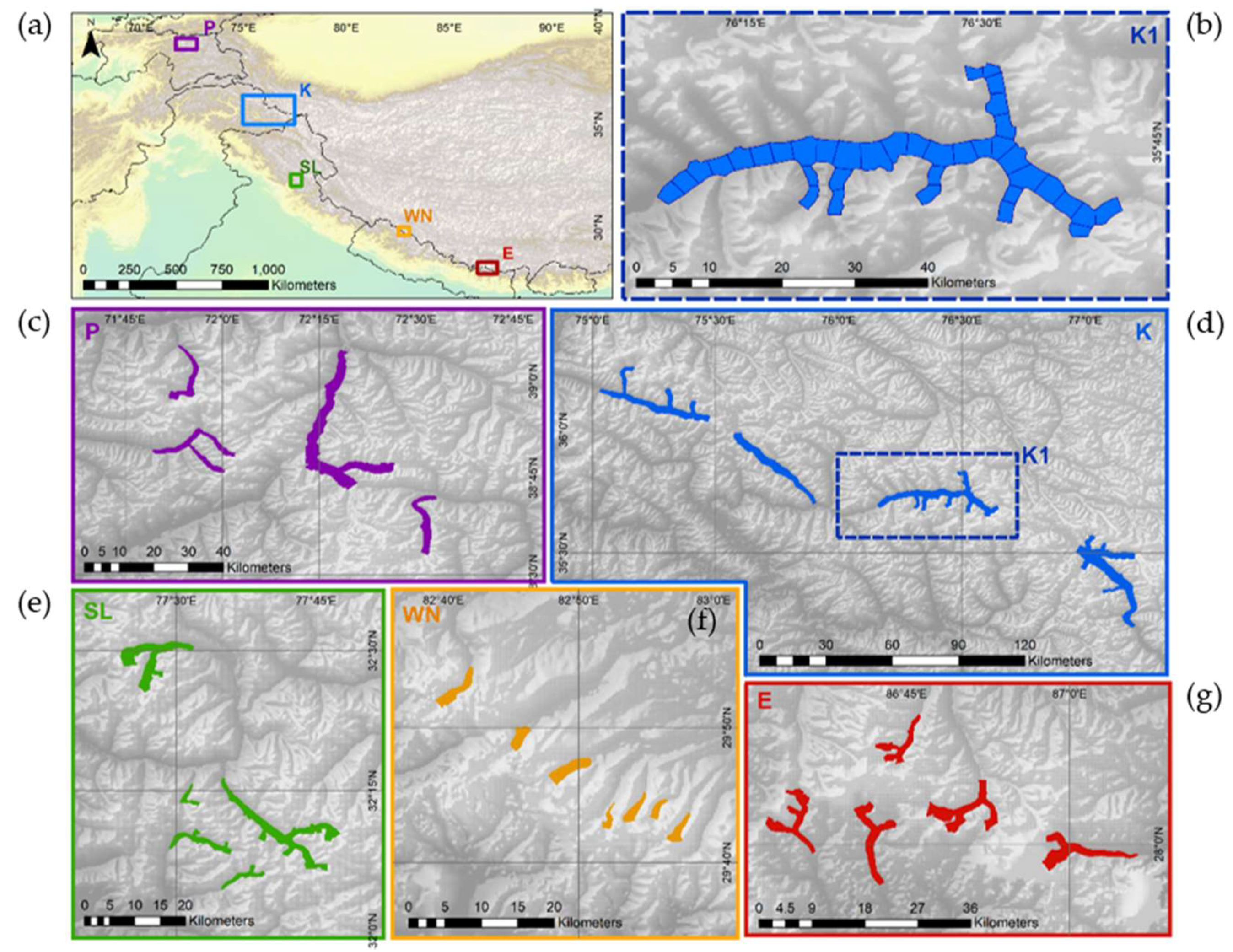
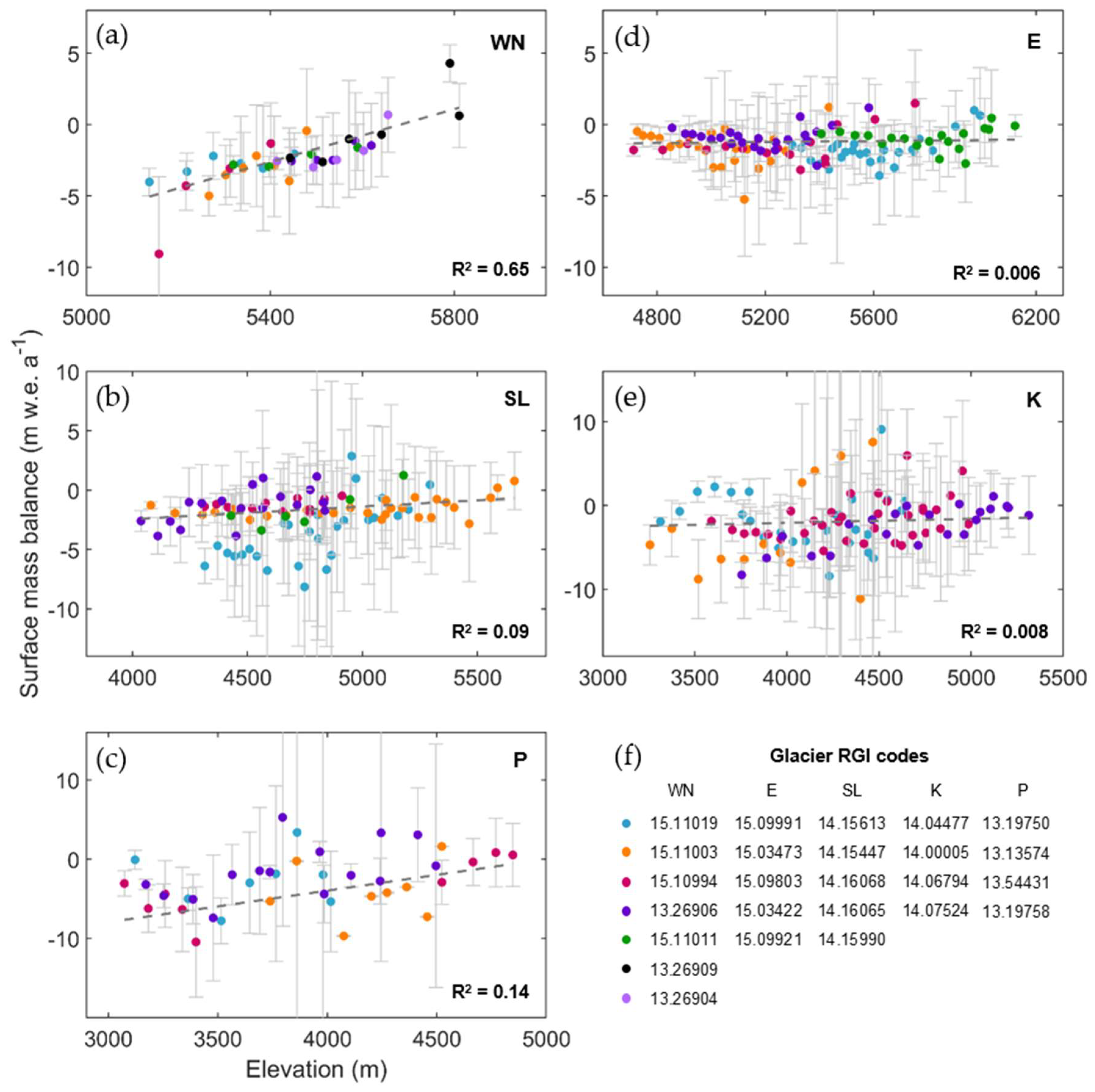
References
- RGI Consortium. Randolph Glacier Inventory—A Dataset of Global Glacier Outlines: Version 6.0. Available online: https://doi.org/10.7265/N5-RGI-60 (accessed on 3 March 2020).
- Pritchard, H.D.; Arthern, R.J.; Vaughan, D.G.; Edwards, L.A. Extensive dynamic thinning on the margins of the Greenland and Antarctic ice sheets. Nature 2009, 461, 971–975. [Google Scholar] [CrossRef]
- Richardson, S.D.; Reynolds, J.M. An overview of glacial hazards in the Himalayas. Quat. Int. 2000, 65–66, 31–47. [Google Scholar] [CrossRef]
- Veh, G.; Korup, O.; von Specht, S.; Roessner, S.; Walz, A. Unchanged frequency of moraine-dammed glacial lake outburst floods in the Himalaya. Nat. Clim. Change 2019, 9, 379–383. [Google Scholar] [CrossRef]
- Veh, G.; Korup, O.; Walz, A. Hazard from Himalayan glacier lake outburst floods. Proc. Natl. Acad. Sci. USA 2020, 117, 907–912. [Google Scholar] [CrossRef] [PubMed]
- Kayastha, R.B.; Takeuchi, Y.; Nakawo, M.; Ageta, Y. Practical prediction of ice melting beneath various thickness of debris cover on Khumbu Glacier, Nepal, using a positive degree-day factor. IAHS Publ. 2000, 264, 71–81. [Google Scholar]
- Östrem, G. Ice melting under a thin layer of moraine, and the existence of ice cores in moraine ridges. Geogr. Ann. 1959, 41, 228–230. [Google Scholar] [CrossRef]
- Lejeune, Y.; Bertrand, J.-M.; Wagnon, P.; Morin, S. A physically based model of the year-round surface energy and mass balance of debris-covered glaciers. J. Glaciol. 2013, 59, 327–344. [Google Scholar] [CrossRef]
- Rounce, D.R.; Quincey, D.J.; McKinney, D.C. Debris-covered glacier energy balance model for Imja–Lhotse Shar Glacier in the Everest region of Nepal. Cryosphere 2015, 9, 2295–2310. [Google Scholar] [CrossRef]
- Wagnon, P.; Linda, A.; Arnaud, Y.; Kumar, R.; Sharma, P.; Vincent, C.; Pottakkal, J.G.; Berthier, E.; Ramanathan, A.; Hasnain, S.I.; et al. Four years of mass balance on Chhota Shigri Glacier, Himachal Pradesh, India, a new benchmark glacier in the Western Himalaya. J. Glaciol. 2007, 53, 603–611. [Google Scholar] [CrossRef]
- Pratap, B.; Dobhal, D.P.; Mehta, M.; Bhambri, R. Influence of debris cover and altitude on glacier surface melting: A case study on Dokriani Glacier, Central Himalaya, India. Ann. Glaciol. 2015, 56, 9–16. [Google Scholar] [CrossRef]
- Nicholson, L.; Benn, D.I. Calculating ice melt beneath a debris layer using meteorological data. J. Glaciol. 2006, 52, 463–470. [Google Scholar] [CrossRef]
- Vincent, C.; Wagnon, P.; Shea, J.M.; Immerzeel, W.W.; Kraaijenbrink, P.; Shrestha, D.; Soruco, A.; Arnaud, Y.; Brun, F.; Berthier, E.; et al. Reduced melt on debris-covered glaciers: Investigations from Changri Nup Glacier, Nepal. Cryosphere 2016, 10, 1845–1858. [Google Scholar] [CrossRef]
- Azam, M.F.; Wagnon, P.; Patrick, C.; Ramanathan, A.; Linda, A.; Singh, V.B. Reconstruction of the annual mass balance of Chhota Shigri Glacier, Western Himalaya, India, since 1969. Ann. Glaciol. 2014, 55, 69–80. [Google Scholar] [CrossRef]
- Nakawo, M.; Young, G. Field experiments to determine the effect of a debris layer on ablation of glacier ice. Ann. Glaciol. 1981, 2, 85–91. [Google Scholar] [CrossRef]
- Lambrecht, A.; Mayer, C.; Hagg, W.; Popovnin, V.; Rezepkin, A.; Lomidze, N.; Svanadze, D. A comparison of glacier melt on debris-covered glaciers in the northern and southern Caucasus. Cryosphere 2011, 5, 525–538. [Google Scholar] [CrossRef]
- Nicholson, L.I.; Benn, D.I. Properties of natural supraglacial debris in relation to modelling sub-debris ice ablation. Earth Surf. Processes Landforms 2012, 38, 409–501. [Google Scholar] [CrossRef]
- Mihalcea, C.; Mayer, C.; Diolaiuti, G.; Lambrecht, A.; Smiraglia, C.; Tartari, G. Ice ablation and meteorological conditions on the debris-covered area of Baltoro Glacier, Karakoram, Pakistan. Ann. Glaciol. 2006, 43, 292–300. [Google Scholar] [CrossRef]
- Kääb, A.; Berthier, E.; Nuth, C.; Gardelle, J.; Arnaud, Y. Contrasting patterns of early twenty-first-century glacier mass change in the Himalayas. Nature 2012, 488, 495–498. [Google Scholar] [CrossRef]
- Gardelle, J.; Berthier, E.; Arnaud, Y. Region-wide glacier mass balances over the Pamir-Karakoram-Himalaya during 1999–2011. Cryosphere 2013, 7, 1263. [Google Scholar] [CrossRef]
- Brun, F.; Berthier, E.; Wagnon, P.; Kääb, A.; Treichler, D. A Spatially resolved estimate of high mountain asia glacier mass balances from 2000 to 2016. Nat. Geosci. 2017, 10, 668–673. [Google Scholar] [CrossRef]
- Shean, D.E.; Bhushan, S.; Montesano, P.; Rounce, D.R.; Arendt, A.; Osmanoglu, B. A systematic, regional assessment of High Mountain Asia Glacier mass balance. Front. Earth Sci. 2020, 7, 363. [Google Scholar] [CrossRef]
- Brun, F.; Wagnon, P.; Berthier, E.; Jomelli, V.; Maharjan, S.B.; Shrestha, F.; Kraaijenbrink, P.D.A. Heterogeneous influence of glacier morphology on the mass balance variability in High Mountain Asia. J. Geophys. Res. Earth Surf. 2019, 124, 1331–1345. [Google Scholar] [CrossRef]
- Sakai, A.; Nakawo, M.; Fujita, K. Melt rate of ice cliffs on the Lirung Glacier, Nepal Himalayas, 1996. Bull. Glaciol. Res. 1998, 16, 57–66. [Google Scholar]
- Brun, F.; Wagnon, P.; Berthier, E.; Shea, J.M.; Immerzeel, W.W.; Kraaijenbrink, P.D.A.; Vincent, C.; Reverchon, C.; Shrestha, D.; Arnaud, Y. Ice cliff contribution to the tongue-wide ablation of Changri Nup Glacier, Nepal, Central Himalaya. Cryosphere 2018, 12, 3439–3457. [Google Scholar] [CrossRef]
- Miles, E.S.; Watson, C.S.; Brun, F.; Berthier, E.; Esteves, M.; Quincey, D.J.; Miles, K.E.; Hubbard, B.; Wagnon, P. Glacial and geomorphic effects of a supraglacial lake drainage and outburst event, Everest Region, Nepal Himalaya. Cryosphere 2018, 12, 3891–3905. [Google Scholar] [CrossRef]
- Banerjee, A. Brief communication: Thinning of debris-covered and debris-free glaciers in a warming climate. Cryosphere 2017, 11, 133–138. [Google Scholar] [CrossRef]
- Nuimura, T.; Fujita, K.; Fukui, K.; Asahi, K.; Aryal, R.; Ageta, Y. Temporal changes in elevation of the debris-covered ablation area of Khumbu Glacier in the Nepal Himalaya since 1978. Arct. Antarct. Alp. Res. 2011, 43, 246–255. [Google Scholar] [CrossRef]
- Nuimura, T.; Fujita, K.; Sakai, A. Downwasting of the debris-covered area of Lirung Glacier in Langtang Valley, Nepal Himalaya, from 1974 to 2010. Quat. Int. 2017, 455, 93–101. [Google Scholar] [CrossRef]
- Cuffey, K.M.; Paterson, W.S.B. The Physics of Glaciers, 4th ed.; Academic Press: Amsterdam, The Netherlands, 2010. [Google Scholar]
- Berthier, E.; Vincent, C. Relative contribution of surface mass balance and ice flux changes to the accelerated thinning of the Mer de Glace (Alps) over 1979–2008. J. Glaciol. 2012, 58, 1979–2008. [Google Scholar] [CrossRef]
- Rounce, D.R.; King, O.; McCarthy, M.; Shean, D.E.; Salerno, F. Quantifying debris thickness of debris-covered glaciers in the Everest Region of Nepal through inversion of a subdebris melt model. J. Geophys. Res. Earth Surf. 2018, 123, 1094–1115. [Google Scholar] [CrossRef]
- Dehecq, A.; Gourmelen, N.; Trouve, E. Deriving large-scale glacier velocities from a complete satellite archive: Application to the Pamir–Karakoram–Himalaya. Remote Sens. Environ. 2015, 162, 55–66. [Google Scholar] [CrossRef]
- Farinotti, D.; Huss, M.; Fürst, J.J.; Landmann, J.; Machguth, H.; Maussion, F.; Pandit, A. A consensus estimate for the ice thickness distribution of all glaciers on earth. Nat. Geosci. 2019, 12, 168–173. [Google Scholar] [CrossRef]
- Farr, T.G.; Rosen, P.A.; Caro, E.; Crippen, R.; Duren, R.; Hensley, S.; Kobrick, M.; Paller, M.; Rodriguez, E.; Roth, L.; et al. The shuttle radar topography mission. Rev. Geophys. 2007, 45, RG2004. [Google Scholar] [CrossRef]
- Kraaijenbrink, P.D.A.; Bierkens, M.F.P.; Lutz, A.F.; Immerzeel, W.W. Impact of a global temperature rise of 1.5 degrees celsius on Asia’s glaciers. Nature 2017, 549, 257–260. [Google Scholar] [CrossRef]
- Scherler, D.; Wulf, H.; Gorelick, N. Global assessment of supraglacial debris-cover extents. Geophys. Res. Lett. 2018, 45, 11798–11805. [Google Scholar] [CrossRef]
- The Global Runoff Data Centre. Major River Basins of the World. Available online: https://www.bafg.de/GRDC/EN/02_srvcs/22_gslrs/221_MRB/riverbasins_node.html (accessed on 9 March 2020).
- Huss, M.; Hock, R. Global-scale hydrological response to future glacier mass loss. Nat. Clim. Change 2018, 8, 135–140. [Google Scholar] [CrossRef]
- Scherler, D.; Bookhagen, B.; Strecker, M.R. Spatially variable response of Himalayan glaciers to climate change affected by debris cover. Nat. Geosci. 2011, 4, 156–159. [Google Scholar] [CrossRef]
- Foresta, L.; Gourmelen, N.; Pálsson, F.; Nienow, P.; Björnsson, H.; Shepherd, A. Surface elevation change and mass balance of icelandic ice caps derived from swath mode CryoSat-2 altimetry. Geophys. Res. Lett. 2016, 43, 12138–12145. [Google Scholar] [CrossRef]
- Abramowitz, M.; Stegun, I.A. Handbook of Mathematical Functions; Dover: New York, NY, USA, 1965. [Google Scholar]
- Azam, M.F.; Ramanathan, A.L.; Wagnon, P.; Vincent, C.; Linda, A.; Berthier, E.; Sharma, P.; Mandal, A.; Angchuk, T.; Singh, V.B.; et al. Meteorological conditions, seasonal and annual mass balances of Chhota Shigri Glacier, Western Himalaya, India. Ann. Glaciol. 2016, 57, 328–338. [Google Scholar] [CrossRef]
- Barandun, M.; Huss, M.; Sold, L.; Farinotti, D.; Azisov, E.; Salzmann, N.; Usubaliev, R.; Merkushkin, A.; Hoelzle, M. Re-analysis of seasonal mass balance at Abramov Glacier 1968–2014. J. Glaciol. 2015, 61, 1103–1117. [Google Scholar] [CrossRef]
- Sherpa, S.F.; Wagnon, P.; Brun, F.; Berthier, E.; Vincent, C.; Lejeune, Y.; Arnaud, Y.; Kayastha, R.B.; Sinisalo, A. Contrasted surface mass balances of debris-free glaciers observed between the southern and the inner parts of the Everest Region (2007–2015). J. Glaciol. 2017, 63, 637–651. [Google Scholar] [CrossRef]
- Wagnon, P.; Vincent, C.; Arnaud, Y.; Berthier, E.; Vuillermoz, E.; Gruber, S.; Ménégoz, M.; Gilbert, A.; Dumont, M.; Shea, J.M.; et al. The cryosphere seasonal and annual mass balances of Mera and Pokalde Glaciers (Nepal Himalaya) since 2007. Cryosphere 2013, 7, 1769–1786. [Google Scholar] [CrossRef]
- Shea, J.M.; Immerzeel, W.W.; Wagnon, P.; Vincent, C.; Bajracharya, S. Modelling glacier change in the Everest Region, Nepal Himalaya. Cryosphere 2015, 9, 1105–1128. [Google Scholar] [CrossRef]
- Anderson, L.S.; Anderson, R.S. Modeling debris-covered glaciers: Response to steady debris deposition. Cryosphere 2016, 10, 1105–1124. [Google Scholar] [CrossRef]
- Rowan, A.V.; Egholm, D.L.; Quincey, D.J.; Glasser, N.F. Modelling the feedbacks between mass balance, ice flow and debris transport to predict the response to climate change of debris-covered glaciers in the Himalaya. Earth Planet. Sci. Lett. 2015, 430, 427–438. [Google Scholar] [CrossRef]
- Sevestre, H.; Benn, D.I. Climatic and geometric controls on the global distribution of surge-type glaciers: Implications for a unifying model of surging. J. Glaciol. 2015, 61, 646–662. [Google Scholar] [CrossRef]
- Meier, M.F.; Post, A. What are glacier surges? Can. J. Earth Sci. 1969, 6, 807–817. [Google Scholar] [CrossRef]
- Paul, F. A 60-year chronology of glacier surges in the Central Karakoram from the analysis of satellite image time-series. Geomorphology 2020, 352, 106993. [Google Scholar] [CrossRef]
- Millan, R.; Mouginot, J.; Rabatel, A.; Jeong, S.; Cusicanqui, D.; Derkacheva, A.; Chekki, M. Mapping surface flow velocity of glaciers at regional scale using a multiple sensors approach. Remote Sens. 2019, 11, 2498. [Google Scholar] [CrossRef]
- Foster, L.A.; Brock, B.W.; Cutler, M.E.J.; Diotri, F. A physically based method for estimating supraglacial debris thickness from thermal band remote-sensing data. J. Glaciol. 2012, 58, 677–691. [Google Scholar] [CrossRef]
- Nicholson, L.I.; McCarthy, M.; Pritchard, H.D.; Willis, I. Supraglacial debris thickness variability: Impact on ablation and relation to terrain properties. Cryosphere 2018, 12, 3719–3734. [Google Scholar] [CrossRef]
- Kirkbride, M.P.; Deline, P. The formation of supraglacial debris covers by primary dispersal from transverse englacial debris bands. Earth Surf. Process. Landf. 2013, 38, 1779–1792. [Google Scholar] [CrossRef]
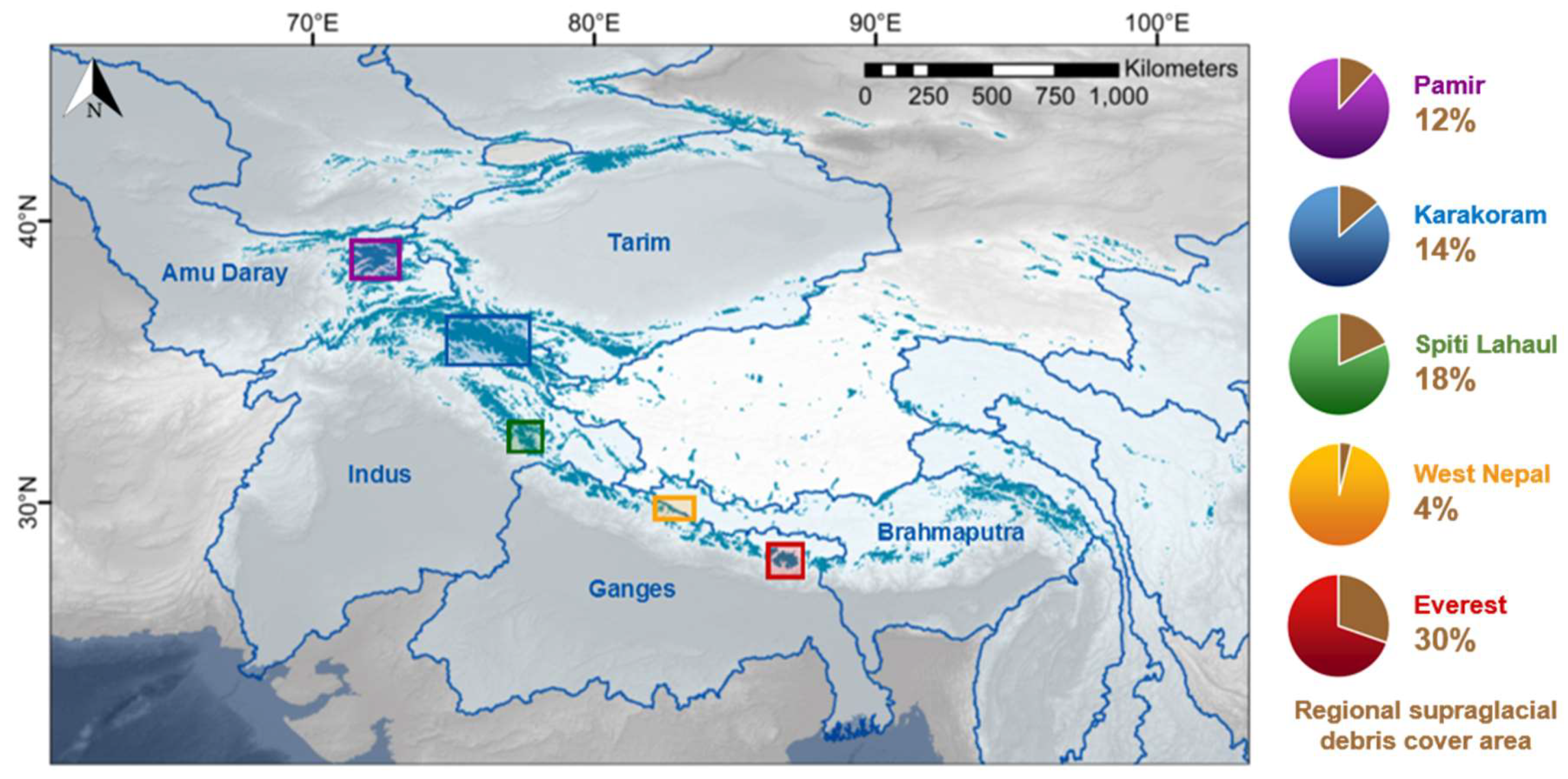
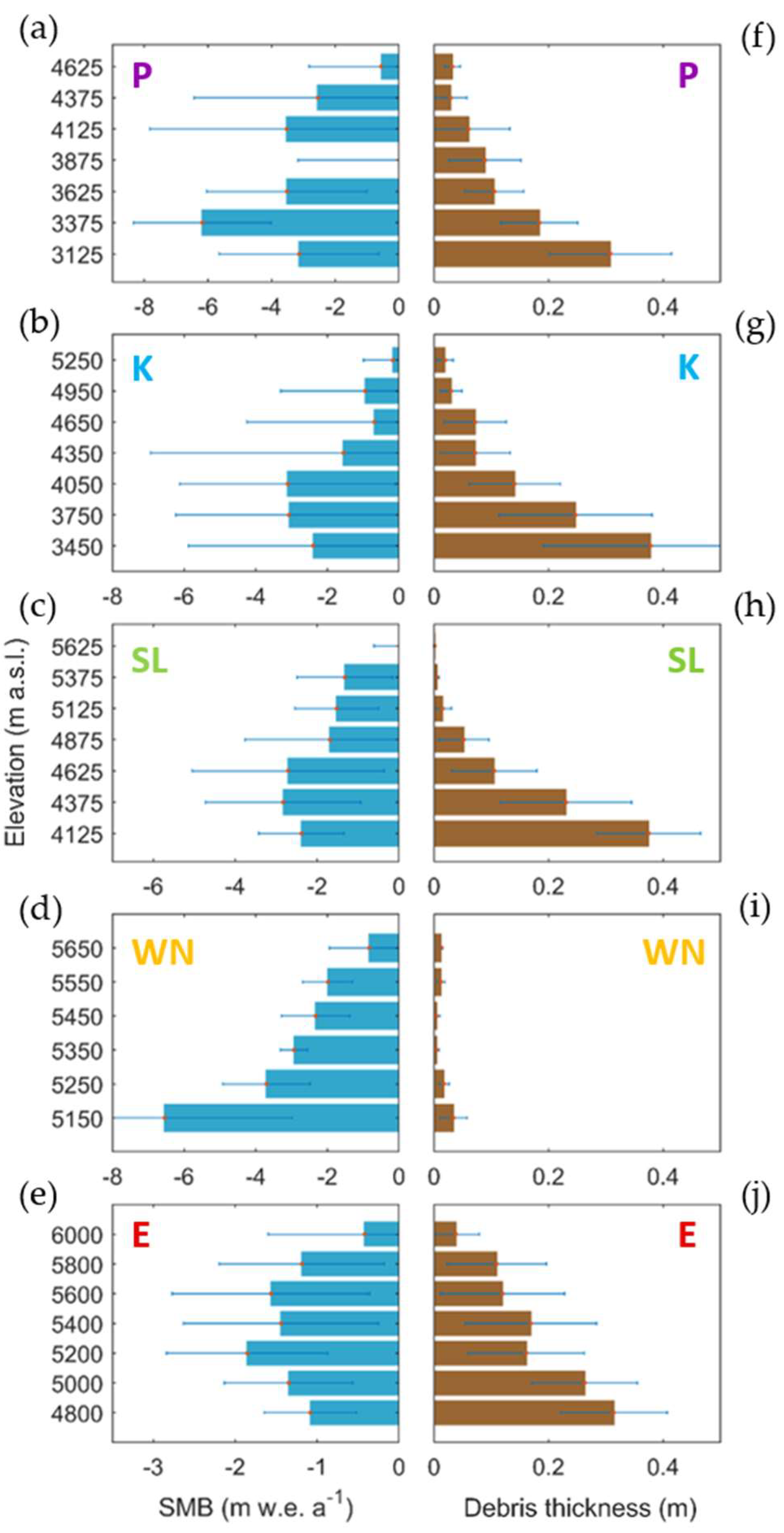
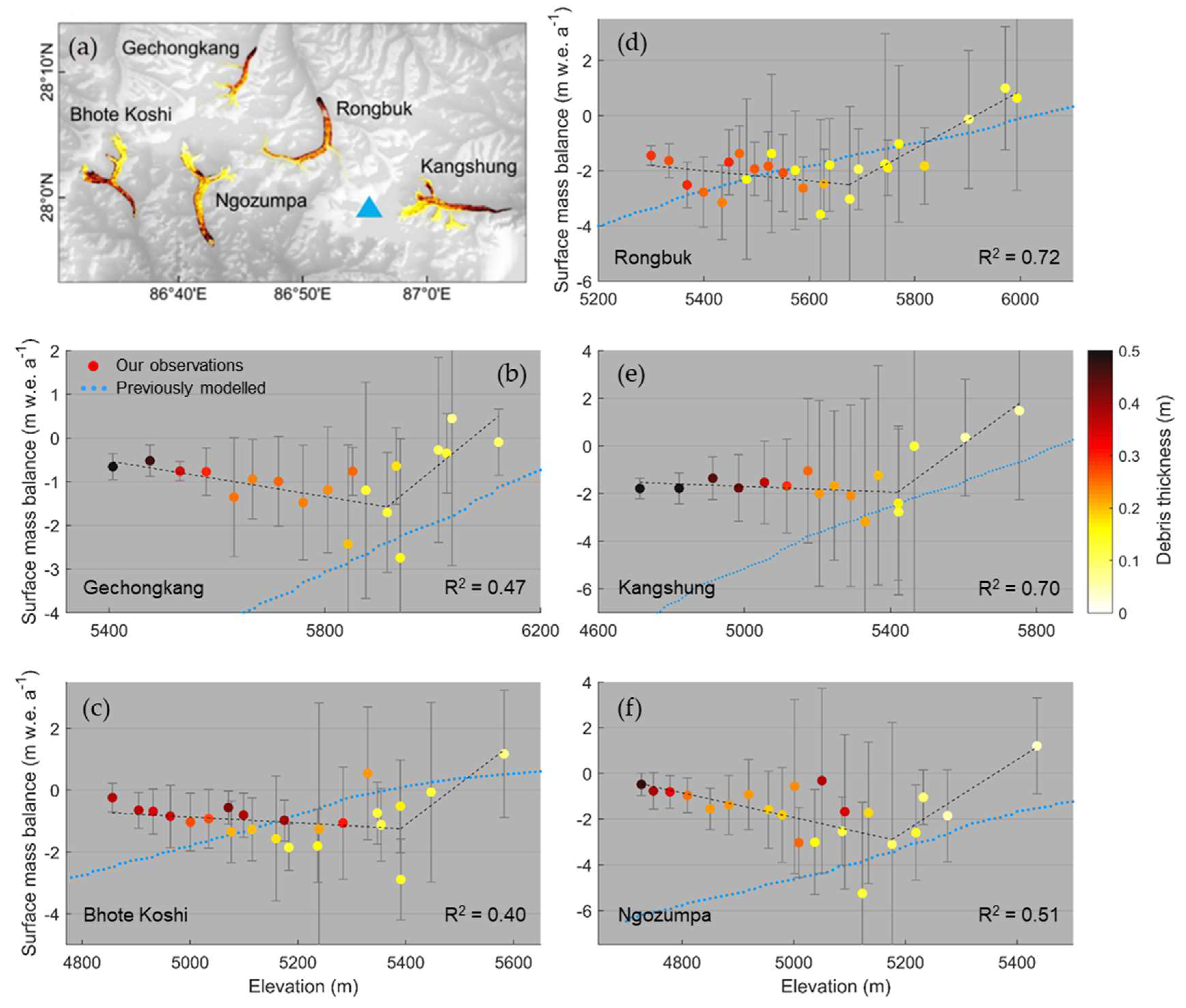
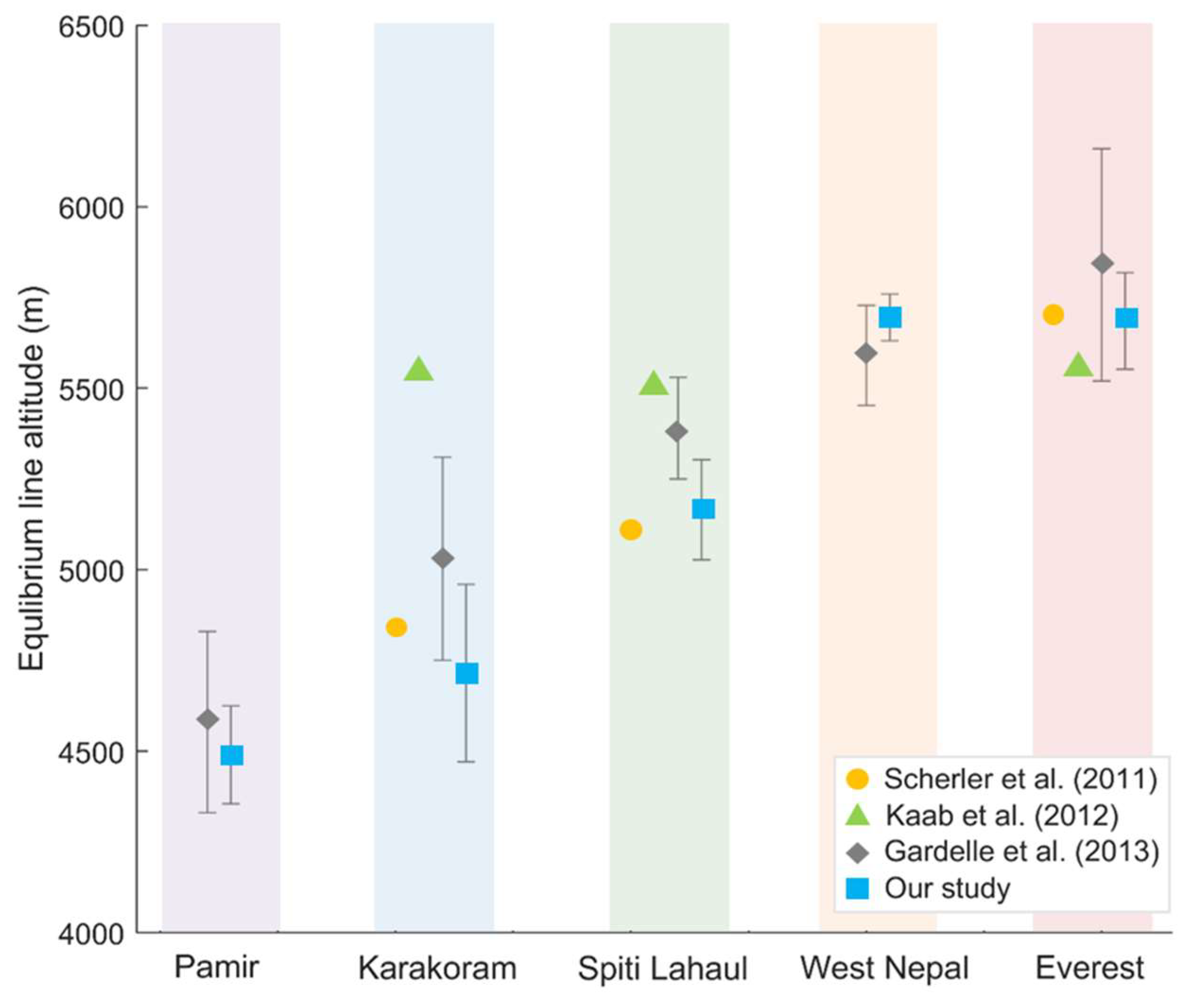
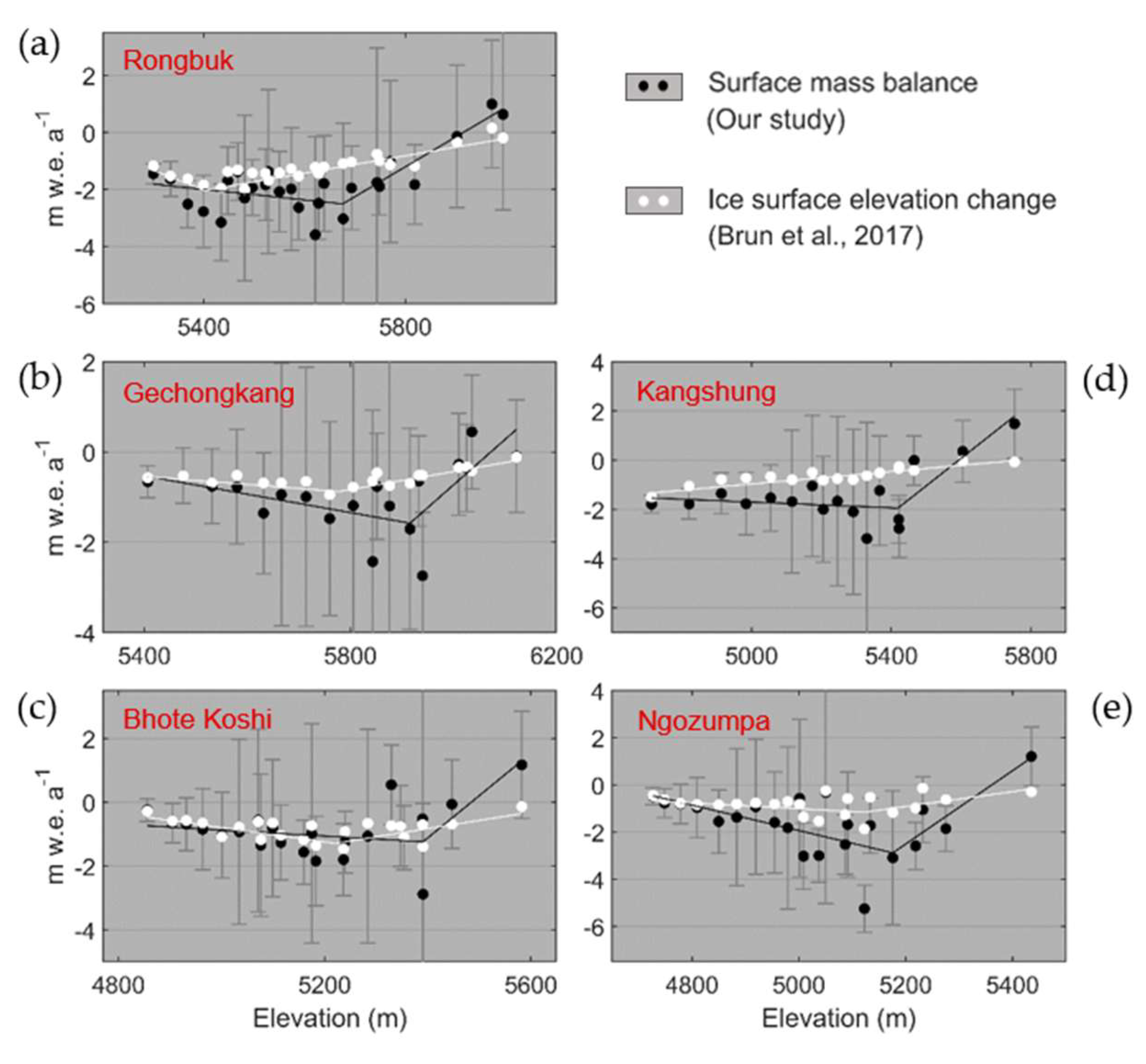
| Region | Mean Breakpoint Elevation (m) | Mean Elevation-Dependent SMB Gradient (m w.e. a−1 (100m)−1) | ||
|---|---|---|---|---|
| Below Breakpoint Elevation | Above Breakpoint Elevation | R2 Value | ||
| Pamir | 3680 ± 280 | −1.87 ± 2.57 | 1.01 ± 0.88 | 0.47 |
| Karakoram | 3860 ± 220 | −1.04 ± 2.08 | 1.05 ± 0.59 | 0.22 |
| Spiti Lahaul | 4890 ± 100 | −0.17 ± 0.30 | 0.94 ± 0.40 | 0.63 |
| West Nepal | Not found | 1.18 ± 0.40 | 0.74 | |
| Everest | 5520 ± 50 | −0.21 ± 0.18 | 1.21 ± 0.41 | 0.56 |
| Measurement Period | Elevation Range (m) | Altitudinal Surface-Mass-Balance Gradient (m w.e. a−1 (100m)−1) | |||
|---|---|---|---|---|---|
| Spiti Lahaul | Everest | Pamir | |||
| Our study | 2000–2015 | 4570–5180 | 0.74 ± 0.14 (CS) | - | - |
| 5420–5750 | 1.12 ± 0.24 (K) | - | |||
| 5180–5230 | - | 1.56 ± 0.49 (N) | - | ||
| 3400–4020 | - | - | 0.74 ± 0.90 (F) | ||
| Azam et al. (2016) [43] | 2002–2014 | 4400–5200 | 0.66 ± 0.09 (CS) | - | - |
| Wagnon et al. (2007) [10] | 2002–2006 | 4400–4900 | 0.69 (CS) | - | - |
| Sherpa et al. (2017) [45] | 2010–2015 | 5330–5690 | - | 1.47 (WCN) | - |
| 2009–2015 | 5430–5690 | 1.37 (P) | |||
| Wagnon et al. (2013) [46] | 2009–2012 | 5500–5600 | - | 1.51 (P) | - |
| Barandun et al. (2015) [44] | 2011–2015 | 3720–4400 | - | - | 1.02 ± 0.05 (A) |
© 2020 by the authors. Licensee MDPI, Basel, Switzerland. This article is an open access article distributed under the terms and conditions of the Creative Commons Attribution (CC BY) license (http://creativecommons.org/licenses/by/4.0/).
Share and Cite
Bisset, R.R.; Dehecq, A.; Goldberg, D.N.; Huss, M.; Bingham, R.G.; Gourmelen, N. Reversed Surface-Mass-Balance Gradients on Himalayan Debris-Covered Glaciers Inferred from Remote Sensing. Remote Sens. 2020, 12, 1563. https://doi.org/10.3390/rs12101563
Bisset RR, Dehecq A, Goldberg DN, Huss M, Bingham RG, Gourmelen N. Reversed Surface-Mass-Balance Gradients on Himalayan Debris-Covered Glaciers Inferred from Remote Sensing. Remote Sensing. 2020; 12(10):1563. https://doi.org/10.3390/rs12101563
Chicago/Turabian StyleBisset, Rosie R., Amaury Dehecq, Daniel N. Goldberg, Matthias Huss, Robert G. Bingham, and Noel Gourmelen. 2020. "Reversed Surface-Mass-Balance Gradients on Himalayan Debris-Covered Glaciers Inferred from Remote Sensing" Remote Sensing 12, no. 10: 1563. https://doi.org/10.3390/rs12101563
APA StyleBisset, R. R., Dehecq, A., Goldberg, D. N., Huss, M., Bingham, R. G., & Gourmelen, N. (2020). Reversed Surface-Mass-Balance Gradients on Himalayan Debris-Covered Glaciers Inferred from Remote Sensing. Remote Sensing, 12(10), 1563. https://doi.org/10.3390/rs12101563





